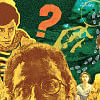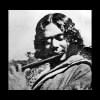Where are Bangla literature’s female detectives?

Before I lay out my case on how females have been portrayed as detectives in Bangla literature, I would like to clarify that I am not at all an expert in this field of thriller or mystery. Detective novels have never been my cup of tea, yet I am aware of prominent detectives like Feluda, Masud Rana, Byomkesh, and Kakababu. They have reigned in the 'case-closed' genre and are celebrated throughout the entire spectrum of Bangla literature. And just as seen until very recently, male protagonists were almost always the norm in Bangla literature. Whodunnit stories aren't an exception either. So I started my very own investigation on where the other half of the demography is shying off to. Turns out, while there surely are literary pieces centred on female private investigators, the only character that made it to the mainstream attention of readers in recent times is Tuntuni from the famous detective series Tuntuni O Chhotacchu (2014) by Dr Mohammad Zafar Iqbal.
The series features Tuntuni, a juvenile mystery enthusiast-cum-amateur detective and her uncle, affectionately called Chhotacchu, who is a full-time professional private detective. Together the two go on to crack various cases from stolen shoes to murdered tycoons. However, the point is that even though Tuntuni is the protagonist of this thriller series, her whole persona seems to be created under the parasol of Chhotacchu being the "real detective". Hence I am still hesitant to put her in the same tier as our prior-mentioned panel of investigators.
But I still know one detective who came to the limelight and showed off her puzzle-solving skills with full pride: Goyenda Ginni. This was an Indo-Bangla television soap opera that my 85-year-old grandma would religiously watch every evening. I remember catching a glimpse of one episode she was watching where the Ginni tried to detect who displaced the rotis from the kitchen. Really? While I'm fully aware that many imperial destructions root back to felonies happening in the kitchen, the premise of that TV show seems to suggest otherwise.
But where are they in the realm of Bangla literature? Turns out, female detectives have existed since the mid 20th century. It all started with Goyenda Krishna (1952), a young college girl who started as an amateur detective and searched for her parent's murderers for vengeance. At a time when crime fiction in Bengal was popular, during the late 19th century to early 20th century, this novel by Probhati Debi Sharashwati was the first attempt to stamp down the male prevalence in the genre.
Unfortunately, early copies of most detective novels in Bangla literature, like Goyenda Krishna and Narayani by Adrish Bardhan, cease to exist to this day due to a noticeable lack of effort to preserve this vast corpus of literature for study. Although the first detective novel in Bangla language dates back to 1892, crime fiction only became popular in Bengal after the 1970s. But if we look back to literary history, the first detective novels were made during the first nationalist movement, when the participation of intelligent, sharp-witted middle-class Bengali men with strong physiques were needed. During this time, the male detectives or goyendas with heroic valour, physical dynamism, and capability of decisive action became popular among the educated middle-class commoners as they took those characters as ideal men.
Unfortunately, early copies of most detective novels in Bangla literature, like 'Goyenda Krishna' and 'Narayani' by Adrish Bardhan, cease to exist to this day due to a noticeable lack of effort to preserve this vast corpus of literature for study.
In addition, the influence of Western literature that paved its way into the subcontinent along with British colonisers was seen in such detective stories. Thus, hyper-masculinised books such as Sherlock Holmes were widely famous among men and women, who had by now become important as readers of regional literature following reform measures taken towards women's education. In the 1950s, Goyenda Krishna and Tapan Bandapaddhayay's Goyenda Gargi (1958) emerged with a college girl and a mathematics major student as protagonists respectively. Although the prominent masculine figure hindered the entrance of women in such a genre, these authors paved the way for girls who could go on adventures and endeavour against injustice. Notably, though, both of these characters start off chasing the evil as a form of vengeance due to personal loss. In the first book of the Goyenda Krishna series, Gupto Ghatok, Krishna's parents were murdered by a pack of serial killers most of whom were avenged by Krishna herself. Most of the detectives I mentioned never sought crime-fighting as a profession, unlike most of their male counterparts who are either police investigators or work under a private agency.
During the mid 20th century, when female wordsmiths somewhat flourished with their newly published works, they were still suppressed under the dominance of male authors. Their rise in the literary world was perceived as a threat to the traditional feminine values of the Bhadromohila who were supposed to reside in the Andarmahal. For this, most novels, including Goyenda Krishna which was published in 1953 by Deb Shahitto Kutir, didn't get enough exposure or even enough printed copies by the publishers to be passed on later on.
One of the more well-known detective series was Goyenda Gondalu (1961) by Nalini Das, Upendrakishore Ray's granddaughter and Satyajit Ray's cousin. Goyenda Gondalu was first published in the children's magazine Sandesh, also created by Upendrakishore Ray and later having Satyajit Ray as editor. However, it begs the question: if the writer wasn't related to these famous men, would she have had the same opportunity or the platform to become this popular?
I would argue that the Mitin Maashi series by Shuchitra Bhattacharya is probably the most-read novel with a female detective in it. Created as the stern refusal to accept analytical intelligence solely as a male attribute, Progyaparamita (known as Mitin Maashi), not only cracks mysteries but also the apparent misogynistic taunts that come along from her surrounding people. Mitin depicts the role of a 'perfect woman' narrative as a counterpart of the 'perfect man' narrative in male-centred novels.
Nonetheless, it's a shame that we lost so many potential masterpieces through the course of time and the unbound curse of unjust societal systems. Though writers like Tapan Bandapadhyay, Adrish Bardhan, and Monoj Sen have tried to bring the female counterparts of the well-known male detectives, they still seemed to stay in the shadows of patriarchy, misogyny, and androcentrism: The Holy Trinity. The survival of these endangered characters can only be ensured if we read them, preserve them, and talk about them. They were the forerunners for lady detectives defying all odds of society; just like how Goyenda Ginni defied all odds to get that bowl of rotis back.
Anika Zaman is a 12th grader studying at Birshreshtha Noor Mohammad Public College. Suggest her fun cat names at [email protected].

 For all latest news, follow The Daily Star's Google News channel.
For all latest news, follow The Daily Star's Google News channel. 











Comments